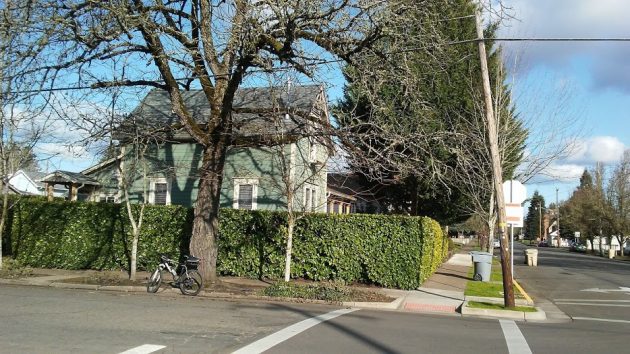
From across the street at First and Main, the alterations at 1105 First would not be visible.
At the risk of beating a dead horse, another story on an old theme: The Albany Planning Division and Landmarks Commission once again have to go through an elaborate and formal procedure to approve minor repairs on an old house.
The owner of the house at 1105 First Ave. N.E. wants to replace the railings on the steps leading to two exterior doors “and associated patios.” Under the Albany Development Code, this requires what the code calls historic review of exterior alterations.
The planning staff has already approved, on its own without a Landmarks hearing, reconstruction of the front porch and railing. The plans changed, and now a hearing on the railings for the steps is needed.
The house dates from the 1890s. According to a survey of historic properties, its porch, railings, stairs, and backyard additions were altered and updated in 1980. So one wonders what’s historic about those railings now.
The Landmarks hearing on this is scheduled for 6 p.m. March 4 in the courtroom at City Hall. First, though, the planning staff has to prepare a staff report. That’s to be available online a week before the hearing. (The first notice of the hearing said the report would be available no later than an hour before the hearing, but that was a mistake, and a new notice will be posted.)
It’s not the fault of the staff or the Landmarks Commission that they have to go through these motions. It’s the code.
There’s no controversy here. In at least a couple of recent cases that were similar –replacing steps in a downtown alley in one case, and a broken garage door and a sliding glass door on a house in the other — there was no public testimony other than from the applicants. And yet the development code apparently required that public notice be given and public hearings be advertised and held.
You’d think that a city council faced with increasing budget pressures would quit wasting time and money on needless procedures and change the code to streamline things. But in this case, you’d think wrong. (hh)

“There’s no controversy here.” And “You’d think that a city council faced with increasing budget pressures would quit wasting time and money on needless procedures and change the code to streamline things.”
Where do you draw the line at what determines the “controversy?” It seems a slippery slope you’re alluding to by wanting to potentially remove rules put in place to insure the historic homes in the historic district stay that way.
One simple fix would be to post a public notice and require a full-blown hearing only if anyone raises an issue. That would save both the city and the applicant time, and probably money too.
While that might “work,” the cynic in me thinks folks would use the usual apathy of folks to be able to circumvent rules of types of materials allowed. Being a historic district comes with rules. And for good reasons IMHO.
You are absolutely correct. They should have to cut down and mill old growth lumber to replace wooden components on historic homes. None of this historically inaccurate modern wood. And heaven FORBID they use an engineered component. That would just destroy the historic nature of everything, especially when it’s covered in all that lead paint.
It\s not rocket science. If someone knowingly buys a historic home in a historic district – they know what they’re getting into…
A couple of points: 1105 First NE is not in any historic district, though it’s listed on the city’s historic inventory. As for “knowingly buying,” online tax records show no sales price when it last changed hands in 2010. So we don’t know if it was bought, inherited or what. Third, the argument here is not against preserving handsome old houses. It’s that for routine exterior repairs like replacing railings, the process is needlessly complicated and wasteful of time for applicants and the city staff. (hh)
There is a lot of cynic in you Ray
Hmmm
My take is that the applicant had to supply a detailed description of current condition, as well as method and material to remedy a deficiency. Then Staff reviews that and frames a decision for the Council.
Seems prudent to set a maximum limit for Staff approval and move on.
Great blog post about the repair of historical homes. It seems that more and more, over approval is needed and could possibly halt or stop necessary improvements or repairs.